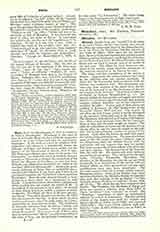

Menaion (menaion from men, “month”) is the name of the twelve books, one for every month, that contain the offices for immovable feasts in the Byzantine rite. As in the West, the Byzantine Calendar consists of two series of offices. First there are the movable days, the days of the ecclesiastical year turning around Easter (roprium de tern pore); overlying this, as it were, are the feasts of our Lord, the Blessed Virgin, and the Saints that are fixed to certain days of the month of the civil year. The offices for these feasts are contained in the menaia, which therefore correspond to the proprium sanctorum in the Roman breviary.
The origin and first compilation of the menaia is obscure. Apparently the various elements that make up the collection were put together gradually. It seems that the Synaxarion (now an extract from the menaia) was composed first. The Synaxarion contains only short accounts of the saints’ lives, the history of the feast and so on, like the lessons of the second nocturn in the breviary. These lives of saints are attributed to Symeon Metaphrastes (q.v.). The menaia include the Synaxarion and supply also all the other texts and poems (the Canons with their heirmoi, troparia, stichera, kontakia, and so on) required to complete the office. A great part of these poems are ascribed to Romanos, the chief hymn-writer of the Byzantine Church (fifth century). The menaia do not affect the holy liturgy (which is hardly influenced by the calendar), being used only in the Divine Office.
The Byzantine ecclesiastical year begins with September. That month therefore forms the first menaion; there is then one for each month to August. The rules for coincidence of feasts and the manner of saying the office on any day must be sought in the typikon; but extracts from the typikon are printed in the menaia. Each office fills five or six small folio pages, the rubrics being printed in red. The general arrangement is this: first come the verses (stichera) sung at the Hesperinos, then the Biblical lessons with the prokeimena and any troparia that may be wanted. The Canon sung at the Orthros follows with all its odes and their troparia. The Synaxarion of the feast follows the sixth ode. The psalms and other unchanging matter are not given. They are found in the other books (Triodion, Parakletike, Oktcechos). The churches of the Byzantine rite that do not use Greek liturgically have translations of the menaia with additional offices for their special feasts and any other modifications they may have introduced. The Slavonic name for the book is mineja, Arabic minaiun, Rumanian mineiu. Parts of the menaia were translated into Syriac by the Melchites during the time that they used that language (a list in Charon: “Le Rite byzantin dans les Patriarcats melkites”, Rome, 1908, pp. 33-44). The whole has not been translated into Arabic. The Orthodox and Melchites of Egypt and Syria use instead a selection from them called in Greek “Anthologion ” (but “minaiun” in Arabic). The
“Menology” (menologion) is either an ecclesiastical calendar or a kind of Synaxarion. The first printed edition of the menaia was made by Andrew and James Spinelli at Venice (1528-1596) and reprinted (1596-1607). The latest Greek editions were published at Venice, in 1873 (Orthodox), and at Rome, in 1888 (Uniate).
ADRIAN FORTESCUE

